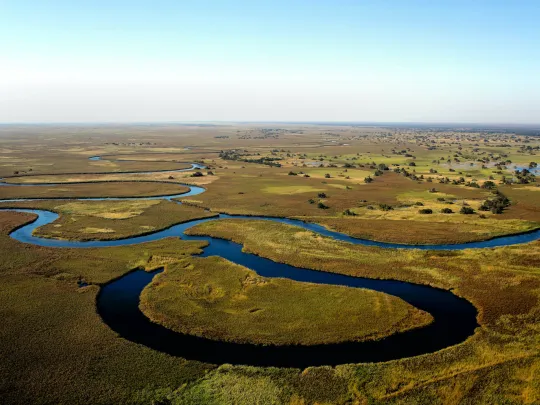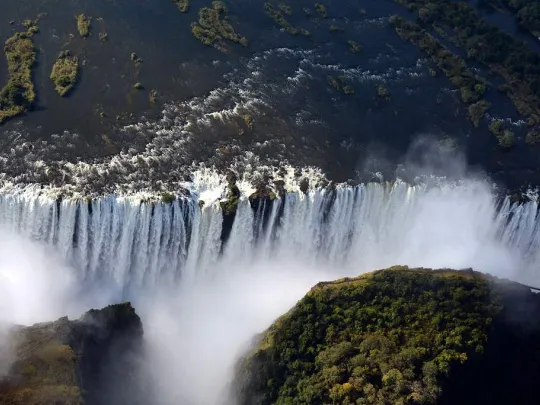Zambezi River Water Levels: How They Affect Your Visit to Victoria Falls
Victoria Falls is one of Africa's most spectacular natural wonders — a place where the mighty Zambezi River plunges over a basalt cliff in a roar of mist and spray. But what many travellers don't realise is that the experience of visiting the Falls changes dramatically throughout the year.
Depending on the season, the water levels can either shroud the view in mist or reveal the gorge's bare rock walls. Knowing what to expect from the Zambezi River's water levels can help you plan the best time to go — whether you're after jaw-dropping views, thrilling activities, or that perfect photo.
Understanding how the Zambezi River's water levels rise and fall with the seasons will help you plan your trip so you don't miss out on the views and activities that make Victoria Falls so unforgettable.
Why Water Levels Matter at Victoria Falls
Located on the Zambezi River straddling the border between Zimbabwe and Zambia, Victoria Falls is known locally as Mosi-oa-Tunya, "The Smoke That Thunders." When you arrive, you'll understand why. The thunderous roar and the towering spray cloud from the 108-metre drop are awe-inspiring — but how much of the Falls you can see (and how soaked you'll get) depends entirely on the time of year.
Here's what to expect throughout the year.
December to March: Water Levels Start Rising

Whitewater rafting at Vic Falls
This is the rainy season in the Zambezi catchment area, when river levels begin to climb and the Falls start to regain their intensity. As water volumes build, the curtain of water thickens and sends spray high into the sky. The rainforest around the Falls bursts into life — flowers bloom, birdlife is prolific, and the experience becomes wonderfully atmospheric.
- Whitewater rafting is excellent until February, though high flows start to limit access to some rapids.
- Devil's Pool on Livingstone Island typically closes in January due to safety concerns as water levels rise.
- Angel's Pool, also on Livingstone Island, usually remains open longer and offers a spectacular view right at the edge of the Falls.
These natural pools are thrilling but only suitable for confident swimmers and those with a head for heights — all visits are supervised by expert guides.
April to June: High Water Season

Vic Falls rainforest covered in spray
By April, heavy upstream rainfall causes the Zambezi River to surge, with up to 500 million litres per minute crashing over the cliff. This is when Victoria Falls is at its most powerful and dramatic — but also when it's least visible from many viewpoints due to the overwhelming spray.
- Expect to get drenched. Visibility from several viewpoints is limited by thick mist. Bring a waterproof poncho or rain jacket, and wear non-slip shoes — the paths can be slippery.
- Ground photography is challenging. The constant spray makes it hard to keep lenses dry and shots clear. Protect your camera lens, and if your phone isn't waterproof, use a ziplock bag or waterproof pouch.
If you want to feel the raw power of Victoria Falls in full flood, this is the time to come — just don't expect clear views on foot.
Best Viewed from the Air: Helicopter and Microlight Flights Over Vic Falls

Helicopter flight over Victoria Falls
When ground visibility is obscured by spray, the best way to appreciate the sheer scale and force of the Falls is from the air. A scenic flight offers a bird's-eye view of the entire 1.7 km curtain of water, the Zambezi River's winding path, and the dramatic Batoka Gorge below.
- Helicopter flights (often called the Flight of the Angels) offer a smooth, stable ride with wide panoramic views — perfect for photos and videos.
- Microlight flights are more adventurous and open-air, allowing you to feel the wind on your face as you soar above the spray.
Both options operate year-round (weather permitting), but April to June is when the Falls are most impressive from above. This is a must-do if you're visiting during high water season.
July to August: Ideal Viewing Conditions

Lunar rainbow tour of Vic Falls
This is the dry season — sunny days, cool nights, and peak safari season. As water levels drop to mid-range, the spray eases, and the full width and height of the Falls come into clear view, especially from the Zimbabwean side.
- Excellent photography conditions from the ground.
- Livingstone Island tours and Devil's Pool re-open, depending on safety conditions.
- Low-water whitewater rafting season begins.
- Ideal conditions for spotting lunar rainbows (visible during full moons).
- Game viewing is excellent in nearby parks like Hwange and Chobe as wildlife congregates around limited water sources.
This is arguably the best time to visit Victoria Falls for balanced water levels, activities, and safari combinations.
September to November: Water Levels Drop Further

Devil's Pool on the Zambian side of the Falls
By September, water levels on the Zambian side of the Falls drop sharply, exposing the underlying geology. By October, much of the Eastern Cataract (Zambia side) may run dry — while Zimbabwe's side remains flowing year-round.
- The scale of the gorge is most visible now.
- Visit the Boiling Pot, a whirlpool below the Falls, for a unique angle.
- Whitewater rafting is at its best, with exposed rapids and thrilling runs.
- Ideal time to swim in Devil's Pool or Angel's Pool.
- Great visibility for Livingstone Island tours.
If you're staying on the Zambian side, it's worth crossing into Zimbabwe to see the Falls flowing. This is also a good time for travellers seeking adrenaline activities and geological exploration.
Livingstone Island: Devil's Pool vs Angel's Pool

Livingstone Island
Perched on the lip of the Falls, Livingstone Island is where explorer David Livingstone first glimpsed the mighty Mosi-oa-Tunya in 1855. Today, guided tours to the island offer a unique perspective and thrilling swimming options.
- Open from July/August to January, depending on water levels.
- Accessible only from the Zambian side (Zimbabwe-based guests must cross the border).
- Includes a scenic boat ride, short hike, and optional gourmet lunch.
Devil's Pool
Swimming on the Edge of the Falls
A heart-thumping experience at Devil's Pool.
Open during low water season (typically August to January), this natural infinity pool allows you to swim right to the edge of the Falls — safely, under the watchful eye of trained guides. It's a once-in-a-lifetime experience.
Angel's Pool

Angel's Pool at Livingstone Island
Smaller and shallower than Devil's Pool, Angel's Pool is an excellent alternative when water levels are too high for its more famous counterpart. It still offers incredible views and a heart-racing thrill.
Planning Your Trip: When to Visit Victoria Falls
The best time to visit Victoria Falls depends on what matters most to you:
- Full power and dramatic spray? Come April–May
- Clear views and epic photos? Choose July–September
- Adrenaline activities like rafting and Devil’s Pool? Opt for August–October.
- Birding and rainforest walks? Visit December–March.
For more expert insights, check out our Victoria Falls Travel Calendar or get in touch for help planning the perfect Victoria Falls itinerary.
Have you braved Devil's Pool or explored Livingstone Island? Share your experience in the comments!
You may also want to look at

Victoria Falls - Zambia side or Zimbabwe side?
Victoria Falls – or " The Smoke that Thunders," as the locals call it – is one of Africa's most iconic and spectacular destinations. Straddling the Zambezi River between Zimbabwe and Zambia, this mighty waterfall leaves many travellers asking: which side should you visit? Let's explore the pros and cons.

Pairing Southern Africa's Top Safari Destinations
When you're planning on flying to Southern Africa for a safari adventure, it helps to know which top destinations can be easily combined. Several of the best safari highlights of the region lie within easy reach of one another, making for a diverse African experience within a manageable timeframe and budget.

12 Day Victoria Falls, Cape Town & Kruger Safari
Combine three of Southern Africa's top destinations—Victoria Falls, Cape Town, and Kruger National Park—on this expertly crafted flexible 12-day adventure. This mid-range itinerary can be fully customised to suit your needs: adjust the order of destinations, extend or shorten your stay at each location, and select accommodations to match your budget or wishlist. Whether you prefer a budget-friendly trip or an upgraded luxury experience, this itinerary promises fantastic natural wonders, vibrant cityscapes, and unforgettable wildlife encounters.
About the author

Dianne Kokkonidis was born in Johannesburg, grew up in the Transkei and spent years exploring Europe. She returned to South Africa to live on a farm in the Outeniqua Mountains when the call of Africa got too loud to ignore. She comes from a family of storytellers, so it's no surprise she's now found her way into writing about one of the oldest stories known to mankind - the lure of Africa.









